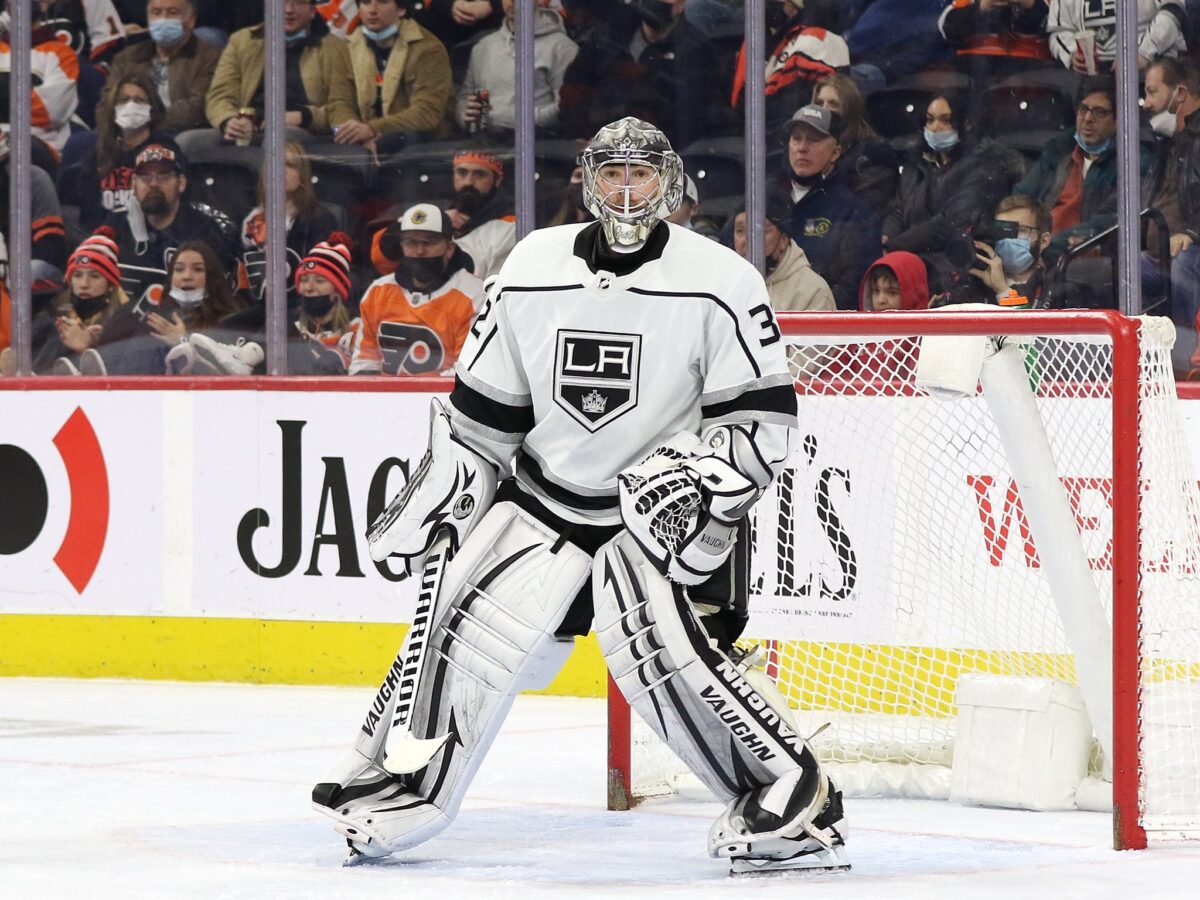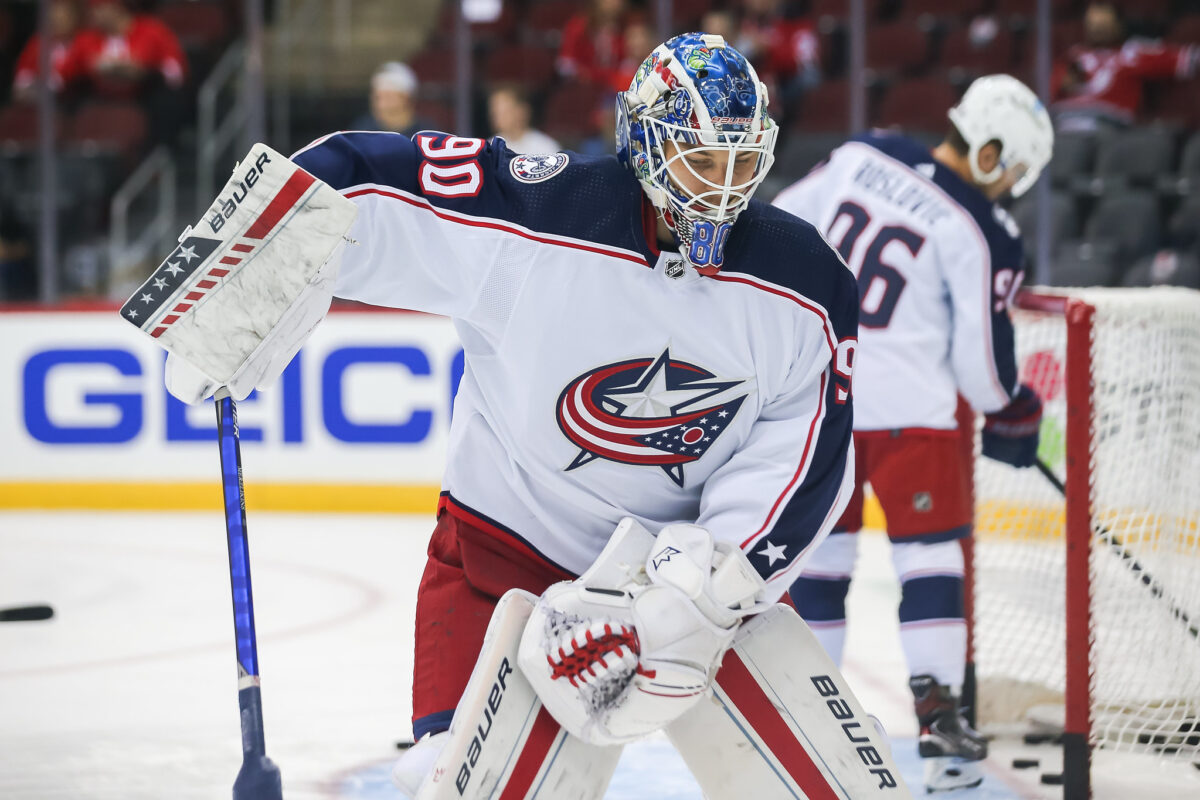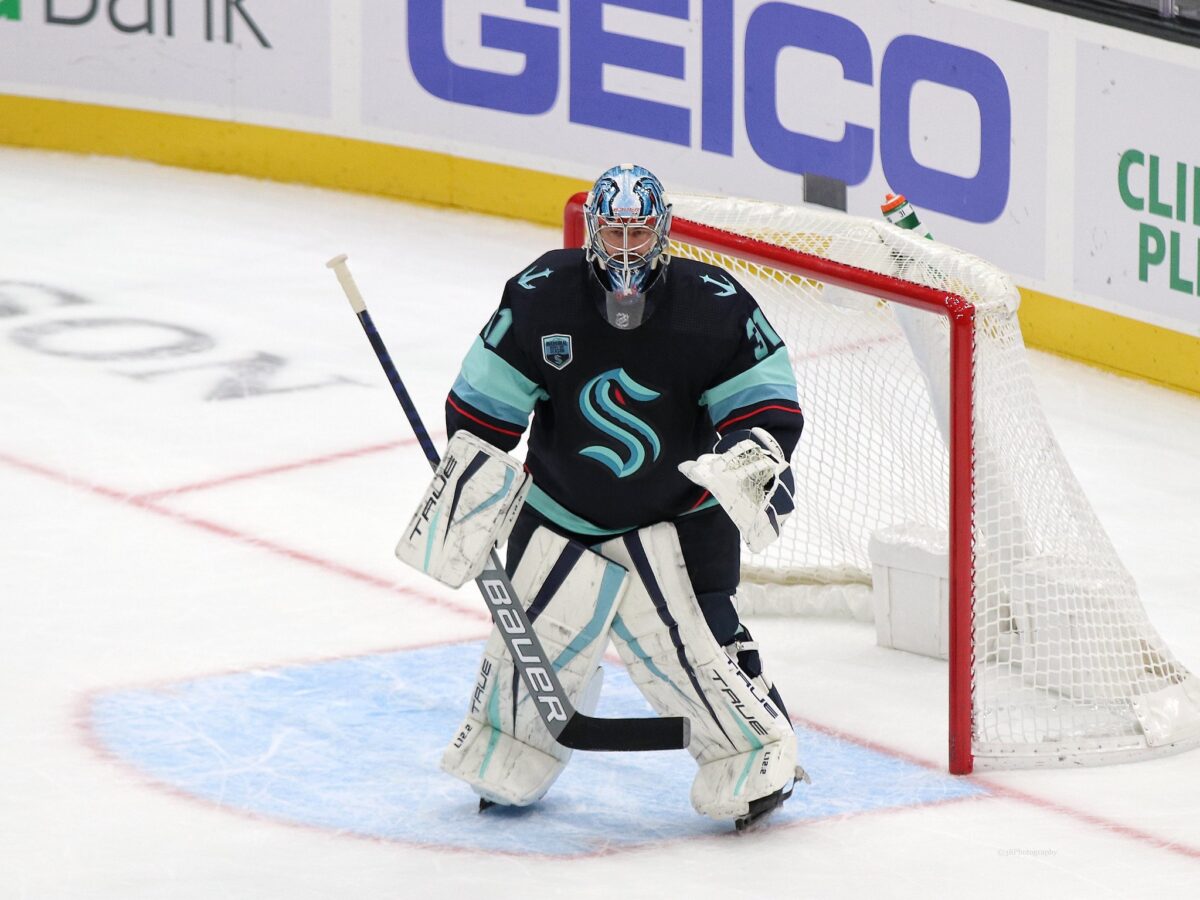Goaltending is arguably the most important position in the NHL. If a goaltender performs at the highest level and among the league’s elite, it can cover up many flaws a team has in front of him. Goalies are also voodoo and the most unpredictable position group in the game. With that said, just because they’re voodoo doesn’t mean we can’t try and predict what the future holds. For this post, we’ll look at three netminders who could regress in 2022-23 and three who could bounce back after difficult years.
NHL Netminders Who May Regress
Jonathan Quick, Los Angeles Kings
After three seasons in which he totaled a .896 save percentage (SV%), Jonathan Quick finished with a .910 SV% across 46 starts — the best he’s posted since 2017-18 when he finished with a .920 SV%. He ended the season with a five-on-five SV% of .925, which ranked 12th in the NHL for netminders with at least 1000 minutes logged at that game state.
However, when you look at Quick’s splits from a season ago, there are some red flags. Through his first 23 games of the season, he recorded a .921 SV%. But things went downhill for him across his final 23 starts, as he recorded a .896 SV%. His five-on-five SV% dipped to .904, and his high-danger SV% of .812 at that game state ranked 13th-worst in the league.

While it was nice to see Quick look prime Quick for the first half of the season, the 36-year-old netminder had three seasons of giving up well more goals than expected. His numbers during the second half of 2021-22 looked more like those previous three seasons, and given his age, I’d expect them to regress to that. That could present a problem for a Kings team looking to build off a surprise playoff appearance if Cal Petersen doesn’t rebound from a sophomore slump.
Anton Forsberg, Ottawa Senators
Before joining the Senators for the 2020-21 season, Anton Forsberg had been a dependable third-string, journeyman netminder. But last season, he broke out and finished with a .917 SV% across 44 starts and 46 games. He posted a career-high goals saved above expected (GSAx) of 11.49 and finished with a five-on-five SV% of .922.
Though Forsberg was more than solid at five-on-five, a significant reason for his success in 2021-22 was on the penalty kill. At all penalty-killing strengths (not just 4-on-5), Forsberg finished with a .914 SV%. Generally, save percentages on the penalty kill, at least among the league’s best goalies, tend to be between .860 and .890. Posting a .914 SV% on the kill is also usually not a repeatable skill. And for a goalie like Forsberg, who doesn’t have a track record of putting up such numbers, it could mean a bit of a come down to Earth.
Does that mean Forsberg will vanish without a trace? No, but expecting a .917 SV% again may be wishful thinking. He’ll also be playing behind a Senators blue line that will likely give up a fair amount of shots and chances, even if Jake Sanderson is NHL-ready. That may mean Forsberg returns to something close to his career SV% of .909 or perhaps a touch below. That’s still above the league average over the last couple of seasons, but that could make a significant difference for a Senators team that will be fighting for a wild card spot in the toughest division in the NHL.
Igor Shesterkin, New York Rangers
Including Shesterkin in the regression part of this article was a difficult decision. He finished with a .934 SV% last season, the seventh-best regular season SV% of all time. But of goalies to post a .930 SV% or better in the last 15 years, only one has done it back-to-back years (min. 25 games played):
| Goalie | SV% and (Season) | SV% Following Season |
| Tim Thomas | .933 (08-09) | .915 |
| Tuukka Rask | .931 (09-10) | .918 |
| Tim Thomas | .938 (10-11) | .920 |
| Pekka Rinne | .930 (10-11) | .923 |
| Cory Schneider | .937 (11-12) | .927 |
| Brian Elliott | .940 (11-12) | .907 |
| Mike Smith | .930 (11-12) | .910 |
| Henrik Lundqvist | .930 (11-12) | .926 |
| Sergei Bobrovsky | .932 (12-13) | .923 |
| Josh Harding | .933 (13-14) | Retired (medical reasons) |
| Tuukka Rask | .930 (13-14) | .922 |
| Carey Price | .933 (14-15) | .934 |
| Brian Elliott | .930 (15-16) | .910 |
| Sergei Bobrovsky | .932 (16-17) | .921 |
| Carter Hutton | .933 (17-18) | .908 |
| Ben Bishop | .934 (18-19) | .920 |
| Anton Khudobin | .930 (19-20) | .905 |
| Igor Shesterkin | .934 (21-22) | TBD |
As seen above, Price is the only goalie who’s repeated the feat. Some have come close to doing so (Henrik Lundqvist, Cory Schneider), but most fell short or well short in the following seasons in which they posted save percentages of .930 or better. Even elite goaltenders who pulled it off (Tim Thomas, Tuukka Rask, Sergei Bobrovsky, to name a few) regressed the following season.
Shesterkin is very much among the elite goaltenders in the game today. If there’s someone who can buck historical trends and pull off back-to-back seasons with a .930 SV%, I’d bet on him being the first to do it since Price seven years ago. But until then, history says the odds are against him. What does regression look like for Shesterkin? I’d be surprised if he posted worse than a .920 SV%, but that could make a difference for a Rangers team that relied heavily on him stopping nearly everything that came his way so they could go to work on the counterattack to score goals at five-on-five.
Goalies Due for Bounce-Backs in 2022-23
Elvis Merzlikins, Columbus Blue Jackets
Merzlikins burst onto the scene as a rookie in 2019-20, posting a .923 SV% in 33 games, which earned him a top-five finish in Calder Trophy voting as the NHL’s rookie of the year. He followed it up with a solid sophomore season where he totaled a .916 SV% and minus-1.66 GSAx, meaning he essentially stopped what was expected of him.
However, Merzlikins’ third season saw a noticeable downturn in his play, as he finished with a .907 SV% and minus-6.54 GSAx. That latter number ranked in the bottom third of the NHL among goaltenders with at least 500 minutes logged at all strengths. And his five-on-five SV% of .916 ranked 34th among goaltenders with at least 1000 minutes logged.

Though Merzlikins struggled a season ago, he was playing behind one of the worst defenses in the NHL with the Blue Jackets. There’s also no doubt that the tragic death of teammate and fellow countryman Matiss Kivlenieks weighed heavily on Merzlikins’ mind throughout the season. So while the Blue Jackets may have had a porous defense, it wasn’t the only reason he had a down year.
Entering the new season, the Blue Jackets will have a bit of a different look after signing Johnny Gaudreau in free agency. Yet, other than adding Erik Gudbranson, their defense remains the same. Merzlikins will likely face plenty of shots and chances again, especially in a highly competitive Metropolitan Division. But even then, I do expect his GSAx to at least break even and his SV% to climb back above the .910 mark.
Connor Hellebuyck, Winnipeg Jets
Hellebuyck was far from terrible a season ago. It just wasn’t what you’re used to seeing from him. He finished 2021-22 with a .910 SV%, the lowest he’s posted since the 2016-17 campaign when he finished with a .907 SV% as a 23-year-old. But when you peek under the hood, his underlying numbers were solid. He finished with a .919 SV% at five-on-five, and his 13.11 GSAx ranked eighth among all goalies.
Sure, that’s the second straight season where his numbers have declined, but a coaching change with the Jets should help. Under former head coach Paul Maurice, the Jets bled shots and quality chances. Their defensive structure wasn’t there, and Hellebuyck faced a lot of work while starting an overwhelming majority of games. With Rick Bowness taking over for Maurice, the team will likely shift to a more defensive system that should help their goaltenders face less work.
Related: NHL’s Top 10 Breakout Candidates for 2022-23 Season
Hellebuyck will turn 30 at the end of the season, so age-related decline starts to creep in as a factor, especially for a goaltender with the mileage he already has. His numbers slipping in each of the last two seasons also raise an eyebrow. But with a new coach whose system should benefit Hellebuyck, I’d still bet on his SV% returning to about the .920 mark. His solid underlying numbers still suggest there’s plenty of good hockey left in him.
Philipp Grubauer, Seattle Kraken
Ahead of their inaugural season a year ago, the Kraken signed Grubauer in free agency to a six-year contract at a cap hit of $6 million. Like the Vegas Golden Knights in 2017, the Kraken’s goal was to be competitive during their first season in the NHL. Grubauer was coming off a Vezina nomination, so having a top-flight goaltender to backstop the team and make noise in the Pacific Division made sense.

Unfortunately for the Kraken, that’s not how Grubauer’s signing played out in his first season. He finished the year with a .889 SV%, the worst of his career, and finished last in GSAx at minus-31.53. His .895 five-on-five SV% ranked last, just behind Mackenzie Blackwood, who finished with a .898 SV% at that game state. His high-danger SV% of .774 ranked second-worst to Blackwood, so no matter what metric you use, it was a bad season for the Kraken’s prized free-agent acquisition.
Though Grubauer may not be an elite goalie at his best, despite having been a Vezina nominee, he is still much better than he was in 2021-22. In his three previous seasons with the Colorado Avalanche, he had a .918 SV% and a GSAx of zero. In the three seasons before then with the Washington Capitals, he had a .923 SV% and 31.74 GSAx, so his success wasn’t just a product of playing for the Avalanche.
Because of his track record, Grubauer seems like the best bet for a bounce-back among NHL goalies this season. Though I do wonder if there’s something the Kraken are doing that’s negatively affecting their goaltenders, given Chris Driedger’s struggles as well, Grubauer should at least be a league-average netminder moving forward. And given his career norms and the solid team in front of him, a bounce-back should look better than league-average netminding.
NHL Goaltending Always Leads to Surprises
Goalies are by far the toughest position to predict in hockey. It’s possible someone who’s been among the league’s top goalies for the last two or three years could have a down season out of nowhere. The same is true for someone who’s struggled for two or three years but ends up as a top 10 goalie by season’s end. It’s part of what makes the sport entertaining and leads to surprises every year, and 2022-23 should be no different.
* * *
Advanced stats from Natural Stat Trick, Evolving-Hockey
